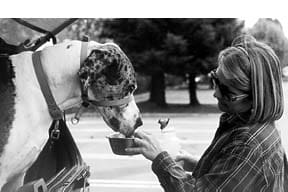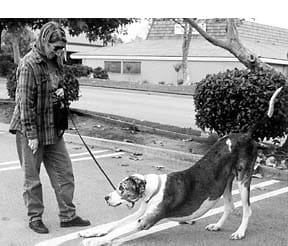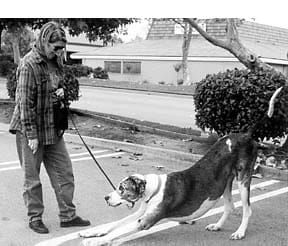I first met Lucy at my local monthly “My Dog Can Do That” competition in January of 1998, at the SPCA in Monterey, California. She was easy to spot – a merle Great Dane with lovely natural ears, who literally towered above the competition. The bond between the dog and her owner was obvious – Lucy was attentive, responsive, performed even the most advanced MDCDT behaviors with ease, and consistently placed in the ribbons.
Lucy’s owner, Kathy Paivinen, communicated with the leggy Dane with gentle, positive cues, and the love that gleamed in her eyes was reflected in Lucy’s return gaze. The 145-pound dog seemed almost perfect – except for her disturbing dislike for Bogart, a hefty male Rottweiler, that occasionally erupted into displays of aggression between the two massive dogs.
Skillful handling by both owners prevented actual fights, but we were careful to park the dogs at opposite ends of the training hall when they arrived each month. We never saw signs of aggression toward humans or the other dogs in the class, and the competitions concluded that summer without serious incident. We chalked up the unhappy relationship between Lucy and Bogart to a personality conflict.

It surprised me, then, when Kathy called me a few months later to ask for help. Lucy had started threatening humans, and her aggression was escalating. This was not appropriate behavior for any dog, but particularly disturbing in one of Lucy’s size, with her potential for causing serious harm.
I agreed to see Lucy. I had worked successfully with dozens of dogs with aggression problems; I had no reason to believe I couldn’t help Kathy with Lucy. Little did I know that she would turn out to be the most difficult challenge of my training career.
We love Lucy
Before starting work with the big dog, I asked and learned about Lucy’s entire life history. Her story was somewhat unusual for a dog with aggression problems.
Kathy Paivinen couldn’t have asked for a cuter, more outgoing puppy when she purchased Lucy from a breeder in the fall of 1995. Although she had her eye firmly fixed on one of Lucy’s siblings, the gangly merle pup made the decision for her. While her littermates tussled together on the floor, Lucy climbed into Kathy’s lap and wouldn’t leave her alone.
An experienced dog owner, Kathy knew that this pushiness could be a sign of dominance, but she was smitten by the puppy’s attentions, and felt that she was capable of handling an “alpha” dog. Kathy, her husband, Mike, and their two-year-old daughter, Anna, agreed that Lucy was the one. As luck would have it, the outgoing puppy turned out to be a very difficult dog. In lesser hands, Lucy would probably not be alive today.
Lucy was not an easy puppy – she had the energy level of a Border Collie and the attention span of a flea. But Kathy knew how important early socialization and training are to a puppy’s development, so she enrolled Lucy in a puppy class at the age of 12 weeks. The puppy class was one of the best around, a Sirius Puppy Training class designed by Dr. Ian Miller, of Berkeley, California, and owner both enjoyed the positive, loosely-structured training environment. Kathy continued to bring Lucy to increasingly more advanced classes as Lucy’s first year passed.
Despite the challenges of the growing pup’s intense personality, she did well in her classes and Kathy was delighted with her progress. The entire family – toddler Anna, husband Mike, and even the family cat – enjoyed the company of the gentle Dane.
Extending training
At the end of the year, Kathy was dismayed to discover that her trainer didn’t offer any advanced classes for adult dogs. Kathy fully realized the value of ongoing training, especially in light of Lucy’s challenging temperament. Plus, she really enjoyed the motivation to keep working with Lucy, as well as the social outlet that the classes provided for both dog and owner. She attended a couple of sessions with a local dog training club, but after the creativity of Sirius training, she and Lucy were bored and frustrated by the march-in-a-circle drill of the only other training classes she found in the area. It just wasn’t fun.
Determined to continue Lucy’s training with the same methods she had started, Kathy searched further afield, and found another Sirius trainer in Carmel, 75 minutes from her Morgan Hill home. It was worth it to her to travel that far for the right kind of training, and she began making the weekly trek to Monterey County to continue Lucy’s positive education. One of the joys of dog ownership for Kathy was taking her dog with her to enjoy the world at large, especially at doggie events. They never missed the monthly “My Dog Can Do That” competitions. In the summer of 1997, Kathy and Lucy participated in the K9 Games at the Monterey SPCA, and that fall they went to the San Francisco Giants’ Dog Day at 3-Com Park. Kathy smiled as she watched her big dog snoozing in the bleachers while strangers stepped over her broad back with impunity. Life was good.
Hints of trouble
But even as Kathy enjoyed outings with her Dane, trouble was brewing just below the surface of Lucy’s deceptively calm exterior. The first incident was unremarkable enough that Kathy didn’t immediately recognize the roots of a serious problem. She and Lucy were working on a training exercise in class in the fall of 1997, when a very large, strange man walked through the door. Lucy took an instant dislike to the intruder, and voiced a series of warning woofs. While the barks were loud, they were not ferocious, and the man worked with Kathy, feeding Lucy treats and reassuring her that he wasn’t a bad guy. Lucy settled down and seemed to accept him, turning her attentions back to Kathy with no further apparent concern.
But in succeeding weeks the man kept coming to class, and every time he entered Lucy would alert on him and bark. Each week he would work with her to calm her down. Each week she would eventually accept him, but it never seemed to stick.
For several weeks Kathy had used positive methods to try to convince Lucy that there was nothing to be upset about, but they didn’t seem to be working. She had attended a Cheryl Smith “Difficult Dogs” seminar and was applying the distract-reward techniques she had learned there. While she could control and calm Lucy each session, the progress never held; Lucy continued to bark at the man every week when he entered the room.
At her trainer’s suggestion, Kathy started using some mild corrections with Lucy when she barked – firm verbal reprimands at first, then a couple of small scruff shakes. Kathy quickly realized that these weren’t doing any good, and discontinued the mild verbal and physical punishment approach.
Unsuccessful approaches
Willing to try anything to get to the bottom of Lucy’s disturbing behavior, Kathy consulted an animal communicator. The woman interviewed her for an hour on the telephone, then met with her in person to give her the bad news. She told Kathy that there was something “really wrong” with Lucy, either chemically or physiologically, and that the big dog posed a serious threat to Kathy’s daughter, Anna, then four years old. She urged Kathy to get rid of Lucy before something tragic happened. She also gave Kathy a calming flower essence remedy for the dog, and suggested massage and acupressure techniques.
A downward spiral
Kathy was understandably upset by the communicator’s message. She tried the flower essence remedy, without noticeable results. She applied the massage techniques, especially working with a specific acupressure point in the ear. While Lucy tolerated this when she was calm, she wanted nothing to do with it when she was stressed. This didn’t help Kathy much, since it was when Lucy was stressed that she most needed to be able to use it. She gave up on massage and flower essences, and continued to search for an answer.

But meanwhile, things were getting worse. Lucy was starting to bark at more people, and Kathy invested in a Citronella no-bark collar as well as a hand-held spray bottle of citronella. When Lucy barked she got sprayed. When she was quiet she got rewarded.
Each time it seemed to work,” Kathy reflects. “It stopped the barking with each incident, but it never carried over to the next one. In fact, it kept getting worse. In contrast, our training was going beautifully – we were working on a Canine Freestyle routine, and preparing to go Sacramento in October of 1998 to do freestyle demonstrations at the Family Pet Expo as part of the Pupperoni K9 Freestylers team.”
Lucy did not have a good time in Sacramento. While some people could walk right up to her without triggering a barking spell, many others could not. Kathy spent most of her time protecting her dog from people who wanted to approach and meet the striking Dane. Lucy’s freestyle routines were acceptable, but dog and owner were both completely stressed by the whole ordeal. Kathy finally began to realize she had a serious problem.
In December of 1998, an incident occurred that made it impossible for Kathy to deny any longer that Lucy’s problem was a tragedy waiting to happen. Kathy had several guests at her home for a holiday party; all dog owners and trainers, all people that Lucy knew. When one of the guests went out on the back deck to give Lucy a treat, Kathy went with her. Lucy snapped at the guest, bit her and broke skin, and also bit Kathy when she tried to intervene. Kathy called me the next day. We agreed to meet at the Santa Cruz SPCA the following week.
Inauspicious first session
That first meeting foretold of difficulties to come. I met Lucy, accompanied by Kathy and her husband, Mike, in the SPCA’s enclosed training yard. As I approached the trio to greet them (cautiously, knowing Lucy’s history) Lucy lunged at me without obvious visible warning.
Mike easily restrained Lucy with her leash and headhalter, but that lunge gave me a lot of important – and disturbing – information: Lucy was stressed even in a fairly low stimulus environment, her aggression was on a hair-trigger, and she did not give clear warning signals. A lack of warning signals is frequently a result of being punished for growling, barking, or snarling in warning, and one of the many reasons that positive trainers don’t recommend punishment to correct aggression. Kathy’s previous physical corrections had been mild, but could have been enough to teach Lucy not to advertise her feelings through lesser body language cues.
I backed off and approached more slowly. After I tossed her several tasty tidbits of Dick Van Patten’s Natural Balance, Lucy seemed to accept me, although she still appeared to be stressed.
I’ve seen and trained a number of aggressive dogs, Lucy’s particularly concerned me. Mike and Kathy had owned Lucy from puppyhood, were experienced dog owners, and had provided her with extensive positive training. They had done everything right, and they still had a major problem.
As I always do with aggressive dogs, I suggested that the couple have their veterinarian conduct a complete examination of the dog to rule out physical conditions that could cause or aggravate Lucy’s aggression.
I also explained the training approach I intended to take. I suggested that we use counter-conditioning and desensitization, by gradually exposing Lucy to people at a safe distance and giving her lots of tasty treats.
Conditioning – not hair care
Counter-conditioning utilizes classical conditioning, and uses a different principle than does operant conditioning (OC), also referred to as “click-and-reward” in the animal training world. In operant conditioning, the trainer clicks and rewards the dog’s voluntary behavior in order to increase the likelihood that the dog will choose to repeat the behavior. When you teach your dog to sit by clicking and rewarding when he sits, you are using operant conditioning.
In classical conditioning, the trainer attempts to affect the dog’s involuntary reaction to a stimulus by associating the stimulus with something that triggers the involuntary reaction. Pavlov’s dogs, who salivated when they heard a bell ring because the bell preceded food, were subjects of classical conditioning.
In Lucy’s case, we wanted to present the stressful stimuli at enough of a distance that it didn’t trigger a strong arousal, and feed her lots of her favorite treats at the same time. Eating is a pleasurable experience incompatible with high levels of stress. If we could replace her stress-induced involuntary reactions with pleasure-induced positive ones, we could change her behavior, that is, counter-condition the response. If we could change the way she thought about the presence of other people from negative to positive, she would no longer feel the need to be aggressive toward them.
The bite of failure
Over the next few weeks we seemed to be making slow progress. We graduated from the protected shelter environment to a nearby shopping center. Lucy appeared to have accepted me, and while she was alert to my approach, she tolerated it and that of other people, as long as we kept them at a distance and they didn’t make direct eye contact. Lucy clearly perceived eye contact as a threat, and would still deliver heart-stopping barks if someone stared or got too close.
On our second visit to the shopping center we had a serious setback. I approached Kathy and Lucy, careful not to look directly at Lucy. As I reached out to offer Lucy her treat she lunged, and hit me just below the right eye with her open mouth. I whirled to the left to avoid the bite and Kathy pulled her back. My cheekbone was bruised, but the skin was not broken. Kathy and I were both shaken, and we sat down to regroup. Perhaps, we decided, we were presenting Lucy with too many stimuli. We decided to retire to a quiet corner of the parking lot for future sessions.
Kathy and I continued for a few weeks, making what appeared to be slow progress. Lucy was still tense about the mall experience. Cautiously optimistic, we worked at having her accept my approaches and departures, and had several sessions without incident. Then, in early April, Mike and Anna attended a session. When I pulled into the parking lot the family was already there. I go out of my van and approached, and once again Lucy lunged for me. This time she managed to rip out a chunk of my hair as I whirled just out of reach of her teeth.
Whether the presence of two more family members added just enough stress to push Lucy past her limits or there was some other reason for her renewal of aggression was less unimportant than the fact that, despite all of our careful work, Lucy seemed to be no further along than when we started. It was time for a new approach.
Saving face – mine!
The Paivinens and I had previously discussed using pharmaceuticals with Lucy and had agreed to try behavior modification first. Now we all agreed that the time had come for drugs. We were doing everything right, and it wasn’t working. Neither Kathy nor I wanted to keep risking my face to Lucy’s teeth, and it was important that we find a way to reach her before she mauled someone. We agreed to contact an animal behavior specialist for some additional help.
From another trainer, I had heard good things about the PETFAX Behavior Consultation Service, centered at Tufts University in North Grafton, Massachusetts. For a reasonable fee ($118), Dr. Nicholas Dodman’s Department of Clinical Sciences will fax an eight-page questionnaire for the dog owner to fill out and fax back. Tufts responds in about one week with a detailed evaluation (Lucy’s was a total of 22 pages) and recommendations for treatment. Kathy started the Tufts process in mid-April, and while we waited for their response we took Lucy back to square one – the enclosed security of the SPCA training yard.
Realizing that my approach to Lucy was triggering her launches, we decided to allow Lucy to approach me instead, while I sat non-threateningly in a chair. This was not as foolhardy as it sounds – we muzzled her first. This proved to be successful, and we continued this technique even as we pursued the Tufts alternative.
Kathy had already had Lucy examined by her own vet, but I requested that she take her to Dr. Terry Spencer, a holistic vet in nearby Salinas, to check for possible chiropractic problems. Tufts had also suggested Lucy be checked for hypothyroidism, which is now recognized as a underlying cause in some aggression cases.
Dr. Spencer did find that Lucy had a fairly serious infection in one ear and a mild urinary tract infection, but everything else checked out fine. Kathy began treating the infections, and we waited for Tufts. The fax from Tufts arrived on May 6. Kathy and I eagerly pored over the pages. We were pleased to read that Dr. Dodman and his associate, Dr. Moon-Fanelli, approved of our training approach. The report stated, “On the positive side, you have been pursuing all the appropriate avenues for treatment, which is a plus since we do not have to ‘undo’ any damage resulting from poor training . . . the desensitization program and click-and-treat training you are working on with Pat Miller is exactly the sort of training we would recommend.”
Tufts also confirmed our conclusion that Lucy’s problem was beyond simple behavior modification, saying, “Given the escalation of Lucy’s aggressive behavior in spite of all your best efforts, incorporating pharmacological therapy into your treatment strategy seems appropriate to us.”
Kathy was already prepared for the bad news, which we had anticipated. Again, Tufts confirmed our conclusion with, “Because her fearful and aggressive tendencies developed as she approached social maturity and have progressively worsened, our prognosis is somewhat guarded in terms of having her become a reliably safe companion.” Kathy was comfortable with the hope of reducing Lucy’s levels of stress and aggression to the point where she felt she could safely control her under reasonable circumstances. She had already resigned herself to putting Lucy’s public freestyle performance career on permanent hold.
Doing drugs
Tufts suggested three drug options for Kathy to discuss with Dr. Spencer. Their first recommendation was fluoxetine (Prozac), although they warned that this drug could be prohibitively expensive for a dog of Lucy’s size. That proved to be the case, and while Kathy was prepared to try it if necessary, we decided to start with Tufts’ second recommendation, the less costly clomipramine (Clomicalm). Clomipramine can cause increased aggression in a small number of cases (about one percent), which is one of the reasons it was not Tufts’ first choice.

In June, about three weeks after Lucy began taking the clomipramine, we began to see a definite change in her behavior. She was noticeably less reactive in the training yard, and volunteered to lie down and relax on her rug instead of standing guard the whole time. As the treatment continued, so did her progress.
Lucy’s interactions with me in the training yard progressed to off-leash with no muzzle, and I even got tail-wagging sloppy kisses in greeting when she arrived. We were seeing a new side of Lucy – a softness in her expression and ear carriage that hadn’t been there before. In fact, prior to starting her on the drug I had asked Kathy if Lucy was ever totally relaxed and happy at home, and Kathy had said that she was. Now Kathy said she realized that – compared to her present state – Lucy never really had been completely relaxed, even at home.
A kinder, gentler dog
After several weeks on the clomipramine we decided it was time for a field trip. Lucy had done well in the agility field next to the training yard where she was exposed to more stimuli, so with some trepidation we decided to try a walk around the neighborhood.
Success! Although Lucy was alert and clearly a little stressed, she navigated heavy traffic, barking dogs from the backs of pickup trucks, bicycles (a strong trigger for her) and a walk through a crowded gas station, all with great aplomb. When we returned to the training yard and turned her loose as a reward, she actually romped! It was the first time I had ever seen her really play, and when Kathy hugged me in thanks we both had tears in our eyes. After so many months of frustration and discouragement we knew we were finally on the right path.
Drugs are currently the subject of much discussion and more than a little controversy in the dog training profession. They are not a solution I would offer for many of my canine clients. On the surface, they seem to be the antithesis of a natural, holistic training program. But “holistic” means looking at the whole picture. On the rare occasion when other positive methods have proven unsuccessful, and in conjunction with an ongoing behavior modification program, I’ve learned that medication just might be the key to making some dogs’ lives whole.
Our work with Lucy is far from done. We have conducted many more sessions in increasingly more stimulating environments, and continue to be encouraged by Lucy’s slow but steady progress. We know that Lucy will never be totally safe and reliable in every setting, and while we may at some point try to gradually wean her off the drug, Kathy is also prepared to keep her on the clomipramine for the rest of her life if that’s what it takes to make Lucy’s life whole.
-By Pat Miller





